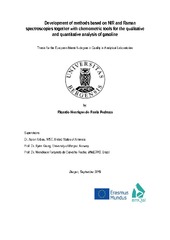| dc.description.abstract | Gasoline quality control is essential for SI engines performance and to reduce environmental impacts by generation of undesirable pollutants. Methods established by the American Society for Test and Materials (ASTM) are the most employed for determining physicochemical quality parameters of motor gasoline, however, these methods present some disadvantages such as time-consuming analysis and need of large amount of sample. For this purpose, near-infrared (NIR) and Raman spectroscopies could be promising alternatives, since they are nondestructive techniques which require little or no sample preparation, a small amount of sample, short analysis time, and also present the possibility of simultaneous determination of many parameters. Although, the use of chemometric tools is often needed in order to extract maximum of useful information from the NIR and Raman spectra related to the parameter being studied. In this work, the qualitative classification of commercial gasoline samples related to their ethanol contents and antiknock indexes was reached by using principal component analysis (PCA) and soft independent modelling of class analogy (SIMCA) models. The values for the misclassification error obtained for the classification of these parameters by both NIR and Raman spectroscopies were less than 3.0%. The multivariate calibration technique, partial least squares (PLS), was used for both NIR and Raman data to obtain predictive models for the quantification of eight physicochemical quality parameters of gasoline such as relative density, motor octane number, research octane number, antiknock index, and gasoline composition by aromatics, benzene, olefins, and paraffins. The accuracy of these PLS models was evaluated by applying the elliptical joint confidence region (EJCR) test, and the ideal theoretical point (slope=1, intercept=0) was involved by the ellipses of all obtained models by both NIR and Raman data demonstrating that BIAS is absent in a confidence interval of 95%. The results obtained in this study demonstrated that both spectroscopic techniques together with chemometric tools provided an excellent performance, thus, being good alternatives to the conventional methods to be used for the quality control of motor gasoline. | en_US |
